 W
WThe Agnes Banks Natural Area is a heritage-listed natural sand deposit, fauna habitat and native flora site at Rickards Avenue in the western Sydney suburb of Agnes Banks in the City of Penrith local government area of New South Wales, Australia. It is also known as The Natural Area and Agnes Banks Sand Deposits. The property is owned by CSR Limited and the NSW Office of Environment and Heritage. It was added to the New South Wales State Heritage Register on 2 April 1999.
 W
WArbanitis robertsi is a species of tube spider in the family Idiopidae found in and near rainforests in New South Wales and Queensland, Australia. A mid to large sized spider which builds a tube of web that extends from the burrow. The tube is attached to rocks, tree ferns or the base of trees. Thousands of these tubes were recorded by Sid Jackson in November 1922 at the south eastern end of Wallis Lake. "Up to three feet long, and half an inch wide". Situated on damp ground, close to freshwater streams.
 W
WArkys curtulus, the small bird dropping spider, is a small spider found in eastern Australia. It is usually seen resting on leaves waiting for prey to come near, commonly feasting on soldier flies. Colours and patterns vary considerably, ranging from cream, orange, mottled, brown or black.
 W
WAtrax sutherlandi is a species of Australian funnel-web spider found in forest on the far southern coast of New South Wales and in eastern Victoria. It was named after Struan Sutherland, whose work resulted in a successful funnel-web spider antivenom.
 W
WThe collared carpetshark is a poorly understood species of carpetshark of the family Parascylliidae endemic to the waters of eastern Australia between latitudes 26°S and 38°S. It is typically found 55–128 m (180–420 ft) in depth near the floor of rocky reefs on the continental shelf, though its depth range can extend between 20 and 230 m. At a maximum length of only 85 cm (2.79 ft), it poses no threat to humans. It is common within its range and is not targeted species. This, combined with high survival rates after discardment and a significant portion of habitat untouched by fishing are why it is listed as Least Concern by the International Union for the Conservation of Nature (IUCN). Reproduction is oviparous and embryos feed solely on yolk.
 W
WCastiarina allensundholmi is a species of beetle in the family Buprestidae, otherwise known as jewel beetles. The species was discovered in October 2003 and was described by Dr Shelley Barker, OAM, in 2005. The three specimens in the type series measure from 7 mm to 8.2 mm. The species belongs in the Castiarina balteata species group which currently comprises three similarly-sized described species: Castiarina balteata, Castiarina williamsi, and Castiarina allensundholmi Barker, 2005.
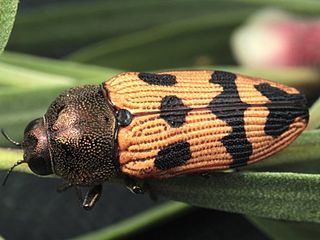 W
WCastiarina turneri Barker 1983 is a beetle in the Family Buprestidae, otherwise known as jewel beetles. The species was described by Dr Shelley Barker, OAM, in 1983.
 W
WKuiter's deepsea clingfish is a clingfish of the family Gobiesocidae, found only off southern Australia, at depths of between 90 and 110 metres.
 W
WThe northern bastard codling is a morid cod of the genus Pseudophycis, found around southern Australia including Tasmania, and New Zealand, from the surface to 220 m. Its length is between 15 and 25 cm.
 W
WThe eel-tailed catfish, Tandanus tandanus, is a species of catfish of the family Plotosidae. This fish is also known as dewfish, freshwater catfish, jewfish, and tandan.
 W
WEuastacus spinifer is a species of freshwater crayfish endemic to Australia that belongs to the family Parastacidae.
 W
WLepidotrigla pleuracanthica, the eastern spiny gurnard, is a species of searobin native to the estuaries and oceanic waters off New South Wales, Australia. This species grows to a length of 20 centimetres (7.9 in) TL.
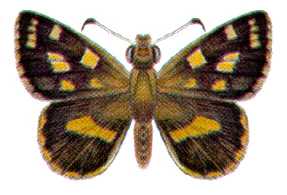 W
WHesperilla crypsargyra, the silvered skipper or silver hedge-skipper, is a butterfly of the family Hesperiidae. It is found in the Australian states of New South Wales, Queensland and Victoria.
 W
WThe High Conservation Value Old Growth forest is a heritage-listed forest located across twelve local government areas in the Northern Rivers, Mid North Coast, and New England regions of New South Wales, Australia. The conservation area is also known as Old Growth Forest; HCVOG Forest; and Upper North East NSW. Broadly speaking, the conservation area forms part of the much larger Gondwana Rainforests, a UNESCO World Heritage site totalling more than 366,000 hectares. The conservation area is owned by the NSW Department of Primary Industries and the NSW Office of Environment and Heritage, both agencies of the Government of New South Wales. The conservation area was added to the New South Wales State Heritage Register on 22 December 2000.
 W
WHoplocephalus stephensii is a species of highly venomous tree snake in the family Elapidae. Its common name is Stephens' Banded Snake. The species is endemic to Australia.
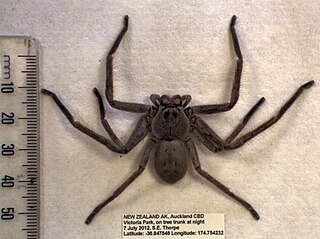 W
WIsopeda villosa is a species of huntsman spider native to New South Wales, Australia, and possibly established in Auckland, New Zealand. It was first described by Ludwig Carl Christian Koch in 1875.
 W
WMicrodrillia fastosa is a species of sea snail, a marine gastropod mollusk in the family Borsoniidae.
 W
WMysticarion porrectus, also known as Helicarion porrectus, is a tree-dwelling snail in the family Helicarionidae. It is endemic to Australia. This species occurs in and near rainforests at high altitude in eastern Australia. It is associated with Gondwana cool temperate rainforests, with trees such as Antarctic Beech, Sassafras and Pinkwood.
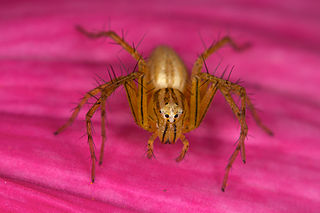 W
WOxyopes elegans is a species of lynx spiders found in Queensland and New South Wales.
 W
WThe spiny pipehorse is a pipefish of the family Syngnathidae, found in the southwest Pacific Ocean on rocky or coral reefs to depths of 230 metres (750 ft). Length is up to 50 centimetres (20 in).
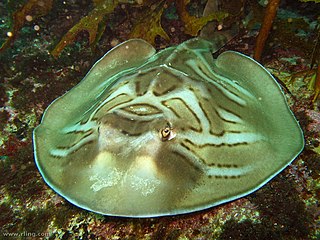 W
WThe eastern fiddler ray, also called the banjo shark, fiddler ray, fiddler, green skate, magpie fiddler ray, parrit, southern fiddler ray or southern fiddler, is a species of fish in the Rhinobatidae family. It is endemic to eastern Australia. Its natural habitat is open seas.
 W
WThe eastern shovelnose ray is a species of guitarfish, family Rhinobatidae.
 W
WThe bullneck seahorse is a pygmy seahorse in the genus Hippocampus. This seahorse has never been found in the wild, and little is known about its natural habitat. The only known specimens were collected on the coast of Eden, Australia. It is thought to live in sand beds at the bottom of the ocean, possibly wrapping its prehensile tail around gorgonian corals. The seahorse is among the 25 “most wanted lost” species that are the focus of Global Wildlife Conservation's “Search for Lost Species” initiative.
 W
WThe blind shark is one of two species of carpet sharks in the family Brachaeluridae, along with the bluegrey carpetshark. Found along the coast of eastern Australia, this nocturnal, bottom-dwelling species is common in rocky areas and seagrass beds from the intertidal zone to a depth of 140 m (460 ft). It often roams in tidal pools where it may be trapped by the receding tide, and can survive for an extended period out of water.
 W
WThe dumb gulper shark is a rare and endangered deepwater dogfish, known from only along the east coast of Australia and isolated spots north and west of New Zealand. It is also known as the dumb shark, Harrison's deep-sea dogfish, or Harrison's dogfish.
 W
WThe leafscale gulper shark is a dogfish of the family Centrophoridae. C. squamosus is reported to have a lifespan of approximately 70 years, based on otolith ring counts. It was the first described species in the genus Centrophorus, which now contains 13 species.
 W
WSidymella rubrosignata is a species of crab spiders found in Australia. It is a common spider, often seen on Dianella plants.
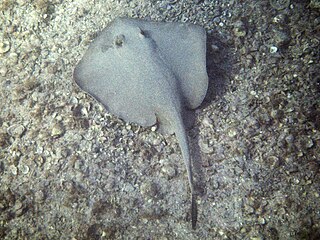 W
WThe greenback stingaree is a little-known species of stingray in the family Urolophidae, endemic to the outer continental shelf and upper continental slope off southeastern Australia. Growing to a length of 51 cm (20 in), this species has a diamond-shaped pectoral fin disc wider than long and uniformly light green in color above. Between its nostrils is a skirt-shaped curtain of skin. Its tail bears skin folds on either side and a deep, lanceolate caudal fin, but lacks a dorsal fin.
 W
WThe Kapala stingaree is a species of stingray in the family Urolophidae, endemic to inshore waters off southeastern Queensland and New South Wales. It is commonly found on and around rocky reefs at a depth of 10–130 m (33–427 ft). Reaching 51 cm (20 in) in length, the Kapala stingaree has a rounded, diamond-shaped pectoral fin disc and a slender tail, which ends in a leaf-shaped caudal fin and bears lateral skin folds and a small dorsal fin in front of the stinging spine. It has a distinctive bell-shaped curtain of skin between its nostrils. This species is greenish above, with a highly variable pattern of dark markings usually found outside and between the eyes, and over the back and tail.
 W
WThe sandyback stingaree or great stingaree is a little-known species of stingray in the family Urolophidae, endemic to southeastern Australia. It is generally found offshore around the edge of the continental shelf, at a depth of 65–265 m (213–869 ft). A relatively large species reaching 89 cm (35 in) long, the sandyback stingaree has a diamond-shaped pectoral fin disc wider than long, usually with a dorsal pattern of numerous fine lighter marks on a yellowish to brownish background. Its short tail terminates in a deep, leaf-shaped caudal fin, and bears a sizable dorsal fin just in front of the stinging spine.
 W
WThe Sydney brown trapdoor spider is a spider in the family Idiopidae, found primarily around Sydney, Australia. It is usually shy and retiring and is often confused with the Sydney funnel-web spider, which is one of the most venomous spiders in the world.
 W
WThe Sydney funnel-web spider is a species of venomous mygalomorph spider native to eastern Australia, usually found within a 100 km (62 mi) radius of Sydney. It is a member of a group of spiders known as Australian funnel-web spiders. Its bite is capable of causing serious illness or death in humans if left untreated.
 W
WThe Wirrimbirra Sanctuary is a heritage-listed fauna sanctuary, native plant nursery, education centre and flora sanctuary located off the Hume Highway at 1305 Remembrance Drive, in outer south-western Sydney in the settlement of Bargo in the Wollondilly Shire local government area of New South Wales, Australia. It was built in 1962 by the Stead Foundation. The property is owned by the National Trust of Australia. It was added to the New South Wales State Heritage Register on 1 March 2002.
 W
WXylocopa aerata, the golden-green carpenter bee or green carpenter bee, is one of two species of carpenter bee found only in the conservation areas around Sydney, and in the Great Dividing Range in New South Wales in Australia. Its only other habitat as of 2020 is on Kangaroo Island in South Australia. The species is especially vulnerable to fire, and much of its habitat was burnt during the 2019-2020 bushfire season in Australia.